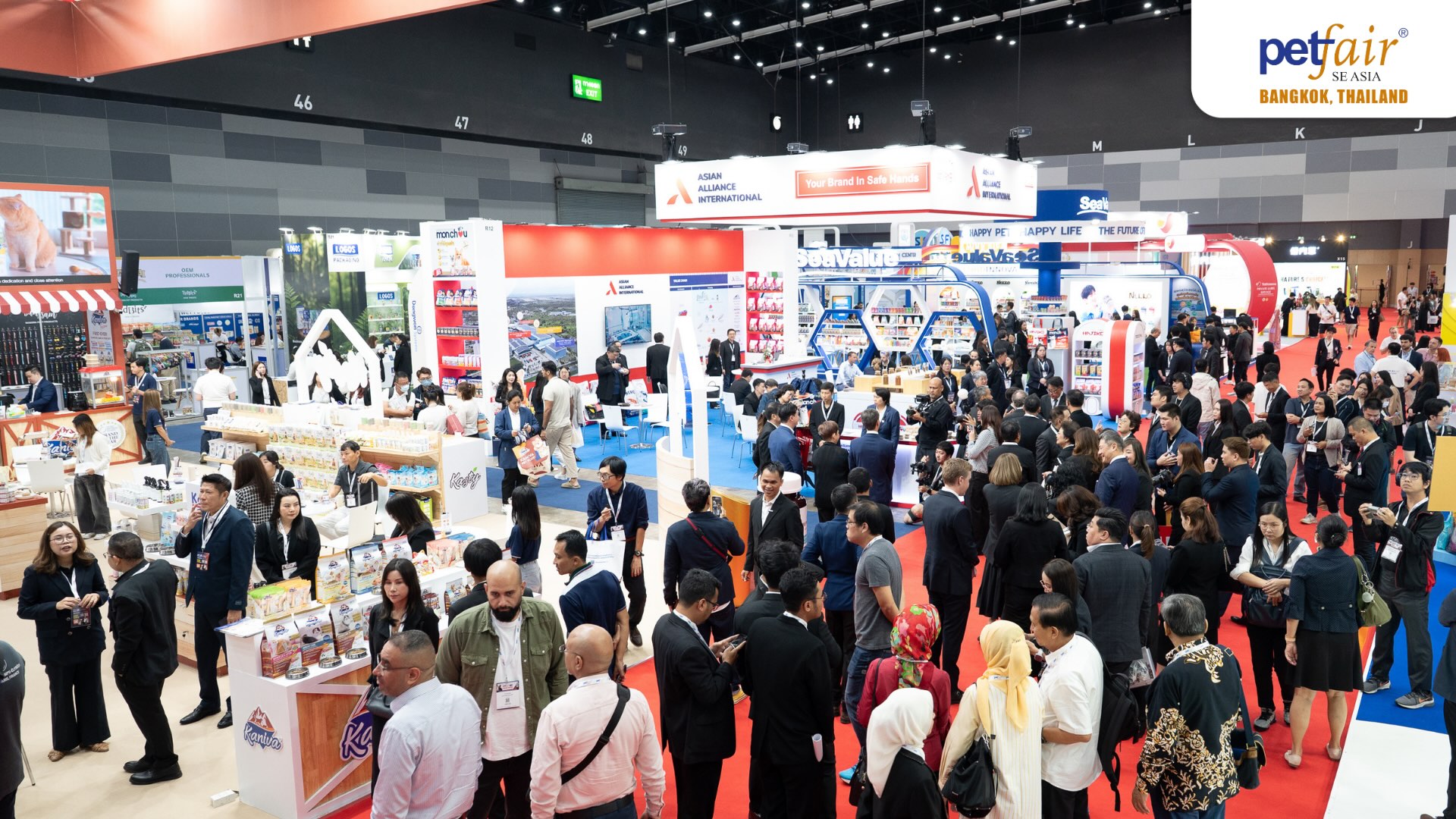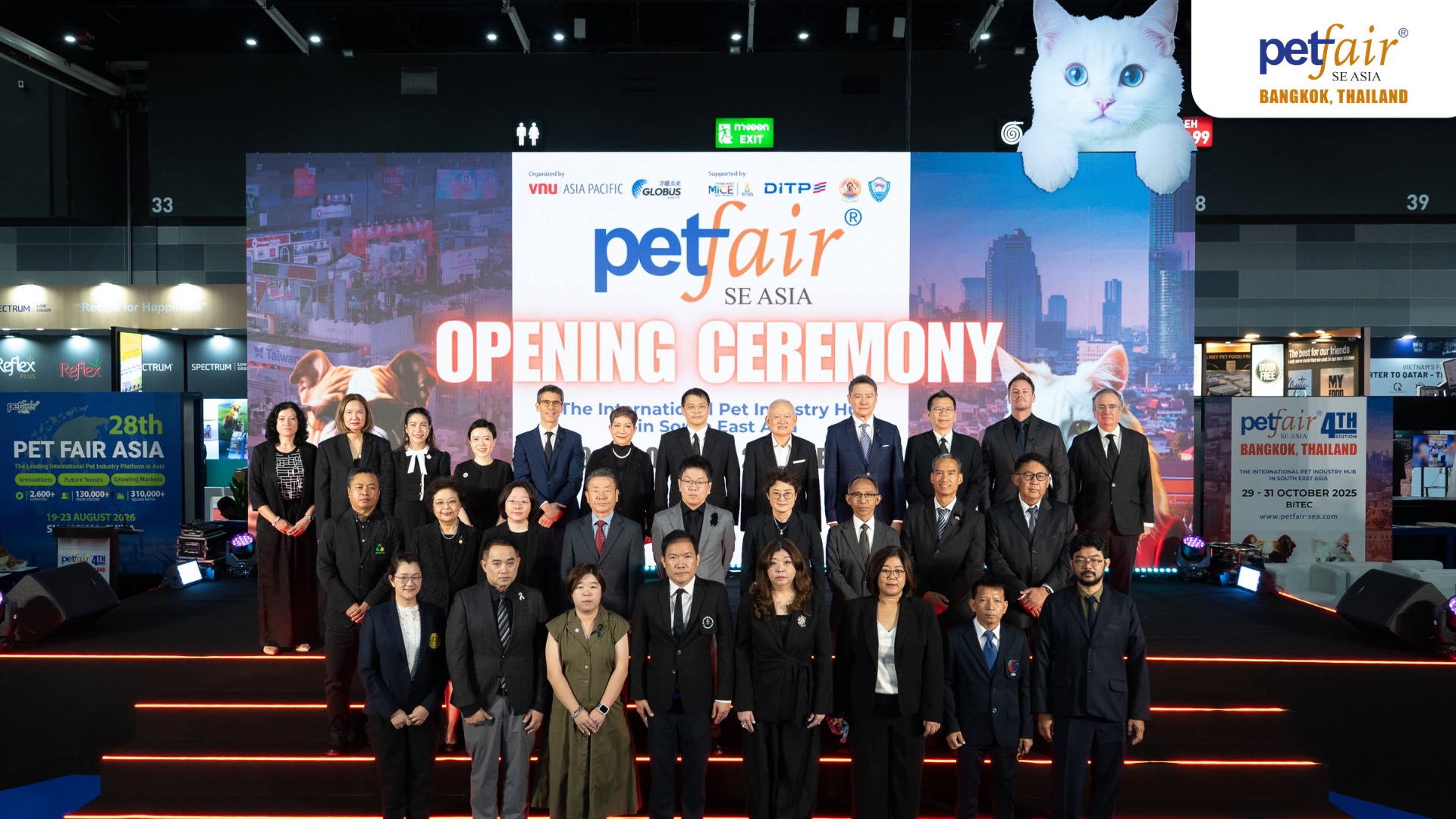The 4th edition of Pet Fair Southeast Asia 2025 has officially opened at BITEC Bangkok, Bangkok, marking a significant milestone for Southeast Asia’s growing pet‑care industry. The event brings together over 450 exhibitors from more than 35 countries, underlining the region’s rising importance as a hub for innovation, sustainability and cross‑border collaboration in the pet economy.
A Region in Motion
Held across approximately 9,500 square metres of exhibition space, the fair showcases a broad spectrum of the pet industry—from ingredients, nutrition and health products to accessories, grooming, pet technology and lifestyle segments. Roughly 60 % of the exhibition area is devoted to pet food, ingredients and healthcare; 30 % to hygiene, accessories and grooming; and the remaining 10 % to emerging categories such as pet technology, apparel, furniture, packaging and carriers.

The show features ten national pavilions representing Canada, China, Italy, Japan, Korea, Taiwan, Thailand, Spain, the UK and the US, emphasising its global reach.
At the opening ceremony, distinguished dignitaries from government, industry and trade associations attended, including Dr. Decha Chatutananant from the Ministry of Industry, Dr. Supawan Teerarat of the Thailand Convention and Exhibition Bureau (TCEB), Dr. Chanintr Chalisarapong from the Thai Chamber of Commerce, Mr. Edwin Tan (CEO of Globus Events) and Mr. Justin Pau (CEO of VNU Asia Pacific).
Thailand’s Strategic Role in the Pet Economy
Thailand is emerging as a key player in the regional pet‑industry value chain. Recent research shows that the country’s pet‐care market is one of the largest in Southeast Asia, valued at around US $1.5 billion in 2023.
According to Thai government data, the domestic pet‑food industry alone reported annual average revenues of around 327.69 billion baht, as of April 2025, with more than 3,659 companies registered in the sector.

In addition, Thai pet‑services revenues (such as grooming, sitting, boarding) are forecast to grow at a compound annual growth rate (CAGR) of about 11.1 % from 2024 to 2030.
The government has flagged the pet sector as an “S‑curve” industry—one of the next growth engines for manufacturing and export. For example, a senior official from the Ministry of Industry emphasised that Thailand’s pet‑market value is projected to reach 92 billion baht in 2025 and could exceed 100 billion baht in 2026.
Business Innovation & Sustainability at the Forefront
This year’s edition introduces several innovations:
- A newly launched digital matchmaking platform enables exhibitors and buyers to connect before the event — improving efficiency and deal‑making.
- The companion “Petfood Forum Asia,” organised by WATT Global Media, offers deep‑dive sessions on product development and manufacturing technologies in the pet‑food segment.
- In line with the show’s sustainability focus, the event has transitioned to a fully digital format: there is no printed show‑guide, and all visitor services and updates are delivered via the official event app.
These developments reflect a broader shift in the market — Thai pet‑owners are increasingly focused on wellness, longevity and sustainability in their pets’ lives. Research by Mintel indicates that urban pet‑owners are looking for products that align with their values, such as eco‑friendly packaging, functional nutrition and mental‑well‑being claims.




Challenges and Strategic Imperatives
Despite impressive momentum, the pet‑industry landscape in Asia (and Thailand) faces a number of strategic challenges:
- As demand for premium pet‑foods and services rises, ensuring consistent product‑quality standards, transparent supply‑chains and regulatory oversight becomes critical.
- Sustainability issues — for example packaging waste or sourcing of pet‑food ingredients — are increasingly front‑of‑mind for younger consumers.
- While domestic growth is strong, export competitiveness depends on capacity, trade logistics and global market access. Thailand has advantages (low production costs, trade agreements, manufacturing base) but must continue to invest in innovation and branding.
- The “humanisation” of pets (viewing pets as full family‑members) means that consumer expectations are evolving rapidly — from mere nutrition to holistic wellbeing. Business models must adapt accordingly.
Why Bangkok, Why Now?
Hosting the fair in Bangkok reinforces Thailand’s bid to be the regional epicentre of pet‑industry commerce and innovation. With infrastructure for trade shows, logistical connectivity in ASEAN, an established manufacturing base and rising domestic demand, Bangkok offers both cost‑efficiencies and strategic access.

As one organiser put it: the event has grown beyond a trade‑exhibition into a “heartbeat” of Asia’s pet industry — where innovation meets partnership and the future of the regional pet economy is being shaped.
Looking Ahead
With the fair running from 29–31 October 2025, stakeholders have a window of three days to forge new partnerships, explore emerging technologies and map strategic expansion into SEA and beyond.
If Thailand succeeds in aligning its manufacturing, innovation ecosystem and regulatory infrastructure with evolving global pet‑industry trends, the country could move from regional player to global exporter — not just of pet‑food, but of services, technologies and lifestyle‑brands for pets.

For international companies and Thai entrepreneurs alike, the message is clear: the pet‑care market is no longer niche but a high‑growth, high‑potential sector. The question is no longer if the market will grow — but how fast, and who will capture the value.
FAQs: Pet Fair SEA 2025 Opens in Bangkok, Reinforcing Thailand’s Role as Asia’s Pet Industry Hub
Q1: What is Pet Fair SEA 2025 and where is it held?
A1: Pet Fair SEA 2025 is Southeast Asia’s leading B2B pet-industry trade show, held at BITEC Bangkok from October 29–31, 2025.
Q2: How many exhibitors and countries are represented at the event?
A2: Over 450 exhibitors from more than 35 countries are participating, including 10 national pavilions.
Q3: What categories are covered at the exhibition?
A3: About 60% focuses on pet food and healthcare, 30% on hygiene and accessories, and 10% on emerging pet tech, apparel, furniture, and packaging.
Q4: What innovations are introduced at this year’s fair?
A4: Highlights include a digital matchmaking platform, the launch of Petfood Forum Asia, and a shift to a fully digital event guide.
Q5: Why is Thailand considered a strategic hub for the pet industry?
A5: Thailand offers strong manufacturing capabilities, growing domestic demand, and is forecast to exceed THB 100 billion in pet market value by 2026.
Q6: What economic impact does the pet industry have in Thailand?
A6: The industry is labeled a new “S-curve” with over THB 92 billion in value projected for 2025, supporting exports and job creation.
Q7: What are some challenges faced by the regional pet industry?
A7: Key challenges include sustainability, quality control, innovation needs, and rising consumer expectations due to pet humanisation.
Q8: How does the fair promote sustainability?
A8: The event uses a paperless approach with a digital app and features sustainable products, aligning with global eco-conscious trends.
Q9: Who are some of the key industry and government figures involved?
A9: Speakers include officials from Thailand’s Ministry of Industry, TCEB, Thai Chamber of Commerce, VNU Asia Pacific, and Globus Events.
Q10: What long-term role does the fair aim to serve?
A10: Pet Fair SEA aims to be a bridge for global companies to enter Asian markets, drive innovation, and promote sustainable growth in the pet sector.



